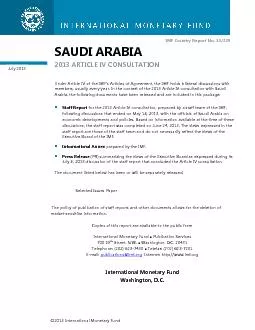PDF-WP Debt and Growth Is There a Magic Threshold Andrea Pescatori Damiano Sandri and John
Author : tatiana-dople | Published Date : 2014-11-10
Notwithstanding this we find s me evidence that higher debt is associated with a higher degree of output volatility JEL Classification Numbers 5736957366573595734725736757363
Presentation Embed Code
Download Presentation
Download Presentation The PPT/PDF document "WP Debt and Growth Is There a Magic Thr..." is the property of its rightful owner. Permission is granted to download and print the materials on this website for personal, non-commercial use only, and to display it on your personal computer provided you do not modify the materials and that you retain all copyright notices contained in the materials. By downloading content from our website, you accept the terms of this agreement.
WP Debt and Growth Is There a Magic Threshold Andrea Pescatori Damiano Sandri and John: Transcript
Notwithstanding this we find s me evidence that higher debt is associated with a higher degree of output volatility JEL Classification Numbers 5736957366573595734725736757363 Keywords Sovereig n de bt growth XWKRU57526V57347 Mail Address apescatorii. Internet: http://www.imf.org Washington, D.C. SSESSMENT REDIT NTERNATIONAL ONETARY AND APITAL EPARTMENT Contents Page I. Introduction ............................................................ Internet: http://www.imf.org International Monetary Fund Washington, D.C. July 2013 Saudi Arabia has been one of the best performing G-20 economies in recent years and has played a key stabilizing Steve Keen. www.debtdeflation.com/blogs. Kickstarter. : . http://t.co/rzFwjEnJ. From the Great Moderation to the Lesser Depression. Sudden decay of economic conditions in 2007-08:. From the Great Moderation to the Lesser Depression. Kunibert. . Raffer. . Folien . zur. . Vorlesung. :. Überschuldung souveräner Staaten und wirtschaftliche Entwicklung. © K. . Raffer. 2016. Waves of Resource Flows. Pearson Report 1969. (official credits). International Monetary Fund. Prepared by Danny Hirsch. 25 October 2015. International Monetary Fund. “The International Monetary Fund (IMF) is an organization of 188 countries, working to foster global monetary cooperation, secure financial stability, facilitate international trade, promote high employment and sustainable economic growth, and reduce poverty.”. Prakash Loungani . Chief, Development Macroeconomics, Research Department, IMF. Co-Chair, Jobs & Growth Working Group, IMF . IDRC/CDESG. October 13, 2015. Views expressed are those of the presenter and should not be ascribed to the IMF.. Jan . Toporowski. SOAS, University of London. ‘At Bretton Woods, Keynes forgot everything he had learned in writing the . General Theory. ’. . (Marcello de . Cecco. , 2011). Paradox of Keynes’ Monetary Thinking. Antoinette M. . Sayeh. , Distinguished Visiting Fellow,. Introduction. Liberia. Mozambique. GDP Per Capita. 205.6. 528.93. Population Below National Poverty Line. 63.8. 54.7. CPIA. 2.8. 3.5. Sources: IMF . travel industry . as Director, . Market Research . at the . U.S. . Travel Association in Washington DC. She . originally . hails from Minneapolis, . Minnesota and currently . resides in Maryland with her husband, son, and daughter. Housekeeping. Brief Note: Why I assigned readings that are generally pro-IMF. : The IMF Benjamin Graham. Reading Quiz (1). Which of the following are true?. Anno di costituzione 2012: Riunisce tre cooperative per un totale di 23 soci di piccola pesca artigianale, e 5 donne occupate.. Attività: . M. OLLUSCHICOLTURA. . DIVERSIFICAZIONE . DELLA MOLLUSCHICOLTURA NELLA LAGUNA DI . Dr. Clemente Landa Domínguez. INTERNATIONAL MONETARY FUND (IMF). International Financial Institution, with headquartered in Washington, D.C.. 189 countries working to foster global monetary cooperation, secure financial stability, facilitate international trade, promote high employment and sustainable economic growth, and reduce poverty around the world.. At the Bretton Woods Conference held in July 1944, delegates from 44 non-communist countries negotiated an agreement on the structure and operation of the international monetary system.. Origin of IMF:. . Introduction. - Monetary policy is concerned with the changes in the supply of money and credit. It refers to the policy measures undertaken by the government or the central bank to influence the availability, cost and use of money and credit with the help of monetary techniques to achieve specific objectives. It aims to influence two major variables:.
Download Document
Here is the link to download the presentation.
"WP Debt and Growth Is There a Magic Threshold Andrea Pescatori Damiano Sandri and John"The content belongs to its owner. You may download and print it for personal use, without modification, and keep all copyright notices. By downloading, you agree to these terms.
Related Documents














